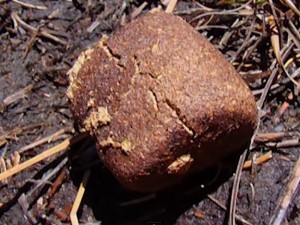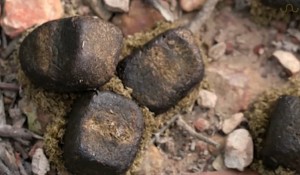Vombatus ursinus or the common wombat is an Australian marsupial. It is a protected species as per Australian laws. Along with its 2 cousins, i.e., the Southern hairy-nose wombat and the Northern hairy-nose wombat, the common wombat is famous for a very weird reason. It is known all over the world as the only animal to defecate poop pellets that are shaped like cubes. It often poops about 100 pellets a day, which are deposited in clusters of 4 to 8.
A few facts about the wombat and its poop are mentioned below.
Wombat poop facts
- Wombat poop is brown hued, about 2 cm high and wide, and forms an almost perfect cube.
- The cubic shape of wombat can be attributed to the lack of moisture in the poop. The digestive process in the marsupial occurs over 14 to 18 days, thereby allowing it to absorb all the nutrients from the consumed food, before eventually eliminating the very dry cubic poop.
- The digestive tract and the colon is very long in wombats. This causes the absorption of all moisture from waste matter leading to very firm and compact poop. The marsupial’s sphincter does not have any role in deciding the shape of the poop. Hence, it breaks of cleanly with flat sides and a cubic shape.
- The wombat has poor vision and typically travels via smell. It uses its poop to mark its territory as well as to know and recognize the region that it is in. It is believed that this is one of the reasons for the frequent pooping habit of the creature.
Other facts about wombat
- The wombat may be a fuzzy looking small creature, but it can sprint really fast. Most types of wombats can sprint at top speeds of 40 km/h or 25 MPH across 150 meters or 164 yards. It can also jump to great heights and can clear fences that are even more than a meter in height.
- The wombat has one of the toughest buttocks in the animal kingdom. In order to defend itself from attacks by other animals, the wombat will jump into a burrow and block the entrance with it’s behind. No animal in Australia can injure its buttocks or pass through the blocked entrance.
- The back legs of the wombat can exert immense power. If it feels trapped in a burrow, then it will slowly lower just enough of its behind so that the predator makes a move to enter its head into the burrow and attack the body or the neck of the wombat. When the predator’s head is just about inside the burrow, the wombat uses its hind legs to drive up its buttocks with immense force, thereby crushing the skull of the predator.
- Just like all marsupials, the wombat also has a pouch in which its offspring are carried. The pouch however faces backwards, so as to prevent dirt being thrown at its offspring when it is burrowing.
- The name has its origins in the Darug language. It was originally written as ‘Whom-batt.’


It’s very easy to find out any matter on web as compared to textbooks,
as I found this paragraph at this website.